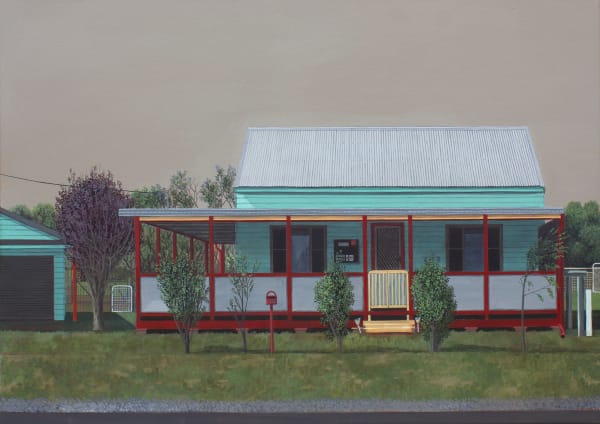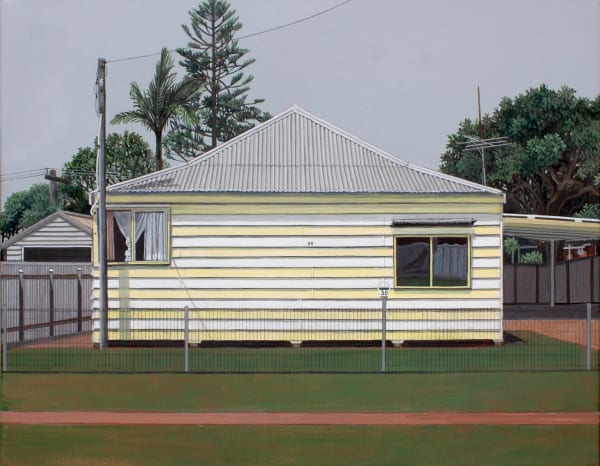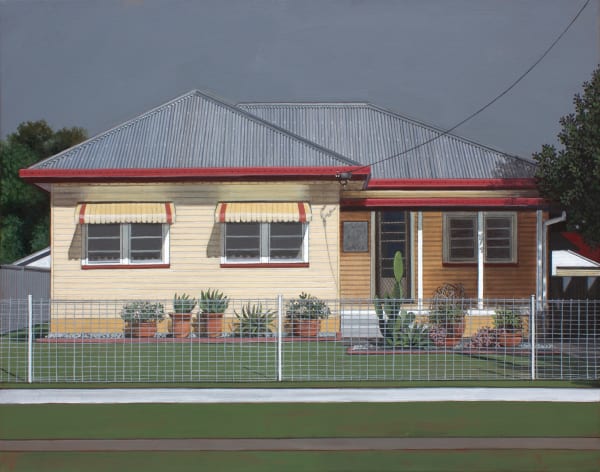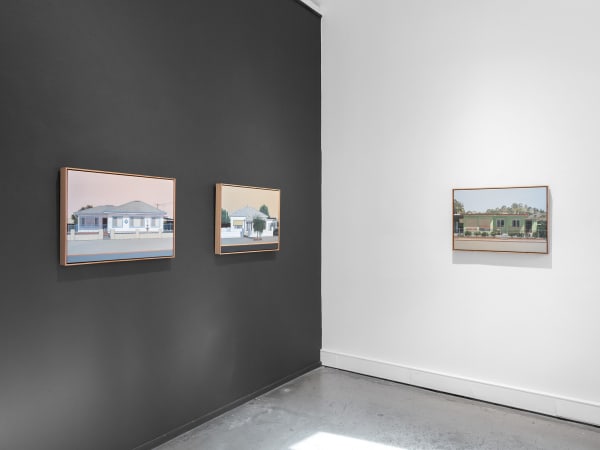Robyn Sweaney: Living on the Edge
-
 Robyn SweaneyAll Our Histories, 2021acrylic on board45 x 180 cm, 48 x 183 cm (framed)Sold
Robyn SweaneyAll Our Histories, 2021acrylic on board45 x 180 cm, 48 x 183 cm (framed)Sold -
 Robyn SweaneyThis Distanced Life, 2021acrylic on polycotton70 x 150 cm, 73 x 153 cm (framed)
Robyn SweaneyThis Distanced Life, 2021acrylic on polycotton70 x 150 cm, 73 x 153 cm (framed) -
 Robyn SweaneyEdge of Beyond, 2022acrylic on polycotton50 x 70 cm, 53 x 73 cm (framed)Sold
Robyn SweaneyEdge of Beyond, 2022acrylic on polycotton50 x 70 cm, 53 x 73 cm (framed)Sold -
 Robyn SweaneyOn the Edge, 2022acrylic on polycotton50 x 70 cm, 53 x 73 cm (framed)Sold
Robyn SweaneyOn the Edge, 2022acrylic on polycotton50 x 70 cm, 53 x 73 cm (framed)Sold -
 Robyn SweaneyDesert Flower, 2022acrylic on polycotton50 x 70 cm, 53 x 73 cm (framed)
Robyn SweaneyDesert Flower, 2022acrylic on polycotton50 x 70 cm, 53 x 73 cm (framed) -
 Robyn SweaneyDeepwater, Born to be Wild, 2022acrylic on polycotton50 x 70 cm, 53 x 73 cm (framed)Sold
Robyn SweaneyDeepwater, Born to be Wild, 2022acrylic on polycotton50 x 70 cm, 53 x 73 cm (framed)Sold -
 Robyn SweaneyDeepwater, Complementary Opposites, 2022acrylic on polycotton50 x 70 cm, 53 x 73 cm (framed)Sold
Robyn SweaneyDeepwater, Complementary Opposites, 2022acrylic on polycotton50 x 70 cm, 53 x 73 cm (framed)Sold -
 Robyn SweaneySoftly Immersive, 2022acrylic on polycotton50 x 70 cm, 53 x 73 cm (framed)Sold
Robyn SweaneySoftly Immersive, 2022acrylic on polycotton50 x 70 cm, 53 x 73 cm (framed)Sold -
 Robyn SweaneyPast Present, 2016acrylic on linen47 x 67 cm, 50 x 70 cm (framed)Sold
Robyn SweaneyPast Present, 2016acrylic on linen47 x 67 cm, 50 x 70 cm (framed)Sold -
 Robyn SweaneyLiving Edge, 2022acrylic on polycotton40 x 50 cm, 43 x 53 cm (framed)Sold
Robyn SweaneyLiving Edge, 2022acrylic on polycotton40 x 50 cm, 43 x 53 cm (framed)Sold -
 Robyn SweaneyHumble Restraint, 2022acrylic on polycotton40 x 50 cm, 43 x 53 cm (framed)Sold
Robyn SweaneyHumble Restraint, 2022acrylic on polycotton40 x 50 cm, 43 x 53 cm (framed)Sold -
 Robyn SweaneyParallel Play, 2022acrylic on polycotton40 x 50 cm, 43 x 53 cm (framed)Sold
Robyn SweaneyParallel Play, 2022acrylic on polycotton40 x 50 cm, 43 x 53 cm (framed)Sold -
 Robyn SweaneyStay Close, Go Further, 2022acrylic on polycotton40 x 50 cm, 43 x 53 cm (framed)Sold
Robyn SweaneyStay Close, Go Further, 2022acrylic on polycotton40 x 50 cm, 43 x 53 cm (framed)Sold -
 Robyn SweaneyBalancing Act, 2022acrylic on polycotton40 x 50 cm, 43 x 53 cm (framed)Sold
Robyn SweaneyBalancing Act, 2022acrylic on polycotton40 x 50 cm, 43 x 53 cm (framed)Sold -
 Robyn SweaneyEarth Garden, 2022acrylic on polycotton40 x 50 cm, 43 x 53 cm (framed)Sold
Robyn SweaneyEarth Garden, 2022acrylic on polycotton40 x 50 cm, 43 x 53 cm (framed)Sold -
 Robyn SweaneyOptimised Aspect, 2022acrylic on polycotton40 x 50 cm, 43 x 53 cm (framed)Sold
Robyn SweaneyOptimised Aspect, 2022acrylic on polycotton40 x 50 cm, 43 x 53 cm (framed)Sold -
 Robyn SweaneyDiffused Threshold, 2022acrylic on polycotton40 x 50 cm, 43 x 53 cm (framed)Sold
Robyn SweaneyDiffused Threshold, 2022acrylic on polycotton40 x 50 cm, 43 x 53 cm (framed)Sold -
 Robyn SweaneyAdaption, 2018acrylic on polycotton40 x 50 cm, 43 x 53 cm (framed)Sold
Robyn SweaneyAdaption, 2018acrylic on polycotton40 x 50 cm, 43 x 53 cm (framed)Sold -
 Robyn SweaneyA Beautiful View, 2021acrylic on polycotton40 x 50 cm, 43 x 53 cm (framed)Sold
Robyn SweaneyA Beautiful View, 2021acrylic on polycotton40 x 50 cm, 43 x 53 cm (framed)Sold -
 Robyn SweaneyEnduring Connection, 2022acrylic on polycotton40 x 50 cm, 43 x 53 cm (framed)Sold
Robyn SweaneyEnduring Connection, 2022acrylic on polycotton40 x 50 cm, 43 x 53 cm (framed)Sold
I don’t think Robyn Sweaney and I are the only people who harbour an emotional connection to the humble working and lower middle class homes of the immediate post-War period. Whether it’s nostalgia or an affection for their unassuming regionalist modernism, they retain an enduring interest.
Ironically, these modest, free-standing houses were the distant descendants of the more elaborate California bungalows of the early 20th Century. But post-War shortages of labour and materials led to restrictions and cost blow-outs which resulted in simple structures, often project homes built according to formulaic designs. Inside, architects (if involved) used their ingenuity to optimise space, while outside the owners sought individual expression through decorative touches – ornamental plants, colourful awnings and decorative fencing and gates.
Yet these houses typically present an anonymous face to the street. While they declare the aspirations of their inhabitants, the actual lives of those people remain private, even mysterious. Their only direct connection to the outside world are the tenuous electricity poles and wires, satellite disks and television antennae.
Seen from the street these houses have a problematic relationship to the viewer and it is that relationship which Robyn Sweaney explores, along with the cultural and social values the houses project. She has trawled the streets of mainly regional towns (like Broken Hill and her home town of Mullumbimby in northern NSW) to identify fast disappearing examples which she photographs, then develops as pencil sketches (to organise the compositional elements) before working up the painted versions.
This process – which can involve the licence of adding or moving elements to achieve formal balance – is important because it results in a painting rather than a reproduction. These paintings are not illustrated essays about the semiotics of post-War Australian houses. Rather they are beautifully crafted examples of how the tension between what is represented and how it is represented leads viewers to discover their own meanings.
For example, we might reflect on the difference between a house and home. Robyn’s houses present as façades. Only occasionally do we get a glimpse of something beyond the façade. But we know that beyond it is a home which nurtures the dreams of those live inside. The structure of the house – the walls and roof – shelters the hearth, around which the residents spend so much of their lives.
Or perhaps we respond to these façades as metaphors, signalling how the face we present to the world serves to protect our fragile inner self. Those small post-War austerity windows are like eyes looking watchfully out on a potentially hostile world, just as the manicured gardens and colourful awnings suggest a playful confidence in the future.
Despite first appearances, these paintings do not lend themselves to photographic reproduction. They need to be seen in the flesh in order to appreciate the grace and care with which the paint is applied, the subtlety of the surface texture and equally subtle tonal relationships. These formal properties give the paintings a contemplative stillness – like a Morandi still life which transforms the everyday into something almost magical.
These paintings are highly abstract compositions of flat planes, no perspectival depth save for the odd shadow cast on a wall, and a sure sense of proportion and balance. They are arrangements of horizontals and verticals, sometimes with almost de Stijl-like patterns of coloured geometric shapes. But they are invariably suffused with a defining light which animates the scene and triggers our empathy for the private world which these façades protect.
Robyn Sweaney has transformed these symbols of modest post-War optimism into objects of restrained aesthetic delight while nudging us into reflecting on what it means to be human.
Paul McGillick
Writer, Architecture, Art & Design

























